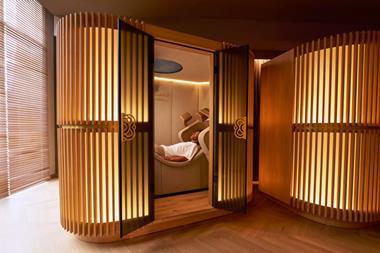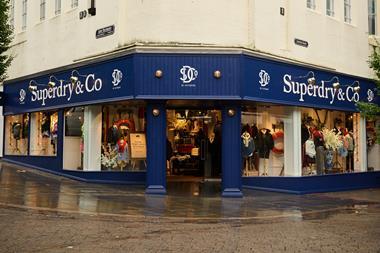Karstadt-owned department store Oberpollinger has emerged from a four-year, £75m luxury makeover. The timing might be off, but John Ryan is won over on its opening night in Munich.
Weil spielen spass macht” (literally: “Because to play fun makes”).
In spite of the curious word order that bedevils the German language, there were few in central Munich last week who would have disagreed with the sentiment expressed by the strapline surmounting a local toy shop. The weather may have been distinctly chilly, but everybody was having fun, shopping mostly, and pausing to quaff cups of mulled wine and calorific cakes in the Christmas market.
Almost none of the shops had reductions, although this probably had as much to do with the strict German laws on when stores can go on Sale as the state of the market. That said, Munich is one of the richest cities in Europe’s economic powerhouse and as such is a honey pot for luxury retailers and brands seeking customers for their wares.
However, last week saw the grand unveiling of a retail project aimed at putting Munich luxury on an even loftier pedestal. Oberpollinger is the city’s most upscale department store, with a historic frontage and a heritage that stretches back to 1905. Located on the central Neuhauser Straße, the seven-floor emporium has been owned by department store operator Karstadt since 1927 and is a feature of the retail landscape in the same way as Harvey Nichols or Selfridges are in London.
About four years ago, Karstadt decided that the 182,990 sq ft (17,000 sq m) store deserved an upgrade and embarked on a major refurbishment programme. However, two years in there was a change of strategy and it was decided that Oberpollinger would join Hamburg’s Alsterhaus and Berlin’s KaDeWe department store as another constituent of its Premium Group division. The aim was now to make the shop a super-luxury department store, placing it in the European “premier league”, as Patrice Wagner, first managing director of Karstadt’s Premium Group, puts it.
To make this a reality, Karstadt hired San Francisco-based Kevin Roche, a name familiar to many US retailers as the man formerly behind design consultancy RYA. Roche was employed as executive director of store planning and design to oversee the process of transformation from upscale to super-luxury store.
And following the usual beauty contest that accompanies such things, Ulm-based architectural and design practice MichelGroup was appointed to work on making the Karstadt vision a reality. Among the modifications to be made was a 172,230 sq ft (16,000 sq m), seven-floor extension to the existing footprint, almost doubling the store’s selling area to 355,220 sq ft (33,000 sq m). To pave the way for the extension, Karstadt bought some land formerly occupied by a synagogue.
BEAUTY AVENUE
The new, modern-looking space has been added to the back of the store and because of its position relative to the existing building, it was immediately apparent that moving shoppers through the space could be a problem. The major difficulty, according to Karstadt director of strategic store planning and design Gerd Pätzold, was the location of the front door, which guided shoppers towards an escalator, opening up the possibility of totally ignoring the new area behind it. To overcome this, the single entrance at the storefront was replaced with two doors that led to separate walkways that skirted a remodelled central area. Dubbed the Boulevard and Promenade, the two avenues beat a path to the beauty hall, the ground-floor showpiece of the shop’s new area.
But before a shopper gets there, there is the rest of the ground floor to consider. Enter via either of the two new entrances and there can be no mistaking this store’s intent. To the left is a Dior shop-in-shop; to the right a Gucci implant. Separating the two, with walkways either side of it, is a concierge area that Roche says will offer “all the services you’d expect in a five-star hotel”.
The concierge service and the large Louis Vuitton shop-in-shop that follows it occupy a space that served as an atrium before the redesign. “I said: ‘Let’s put Louis Vuitton in the atrium and get them in’,” says Roche, speaking of what was required to get Louis Vuitton and others like it to join the Oberpollinger party.
The walkways, which take shoppers from the front to the back of the store, create two very upmarket high streets with designer shops along its length. And the point is that many of the shop-in-shops found at Oberpollinger are as large as some of the brands’ standalone branches in other locations. With names such as Miu Miu, Mont Blanc, Burberry and Prada, you’d expect a sense of exclusivity and the store does not disappoint.
Roche explains that part of his role has been to contain the brands’ enthusiasm to devise spaces that will differentiate them from their neighbours. He says that the store envelope remains Oberpollinger and that shoppers should be aware of where they are, whatever the interior blandishments from the couture offers.
And so to the beauty hall. Although almost everything at Oberpollinger is new, this is where the feeling of novelty is at its most obvious. A high free-standing wall, which serves to keep the escalator and its associated atrium discrete from the beauty hall, has been covered with a large section of Michelangelo’s The Creation of Adam, tastefully rendered in sepia tones.
The rest of the hall is effectively a white box, broken up by the creations of the various brands that have taken space within it. While this may sound like standard stuff, the execution certainly puts it into the same league as, say, Selfridges or Galeries Lafayette.
Heading upstairs, pausing to admire the tessellated perspex screen that runs along one wall of the escalator atrium and the Veuve Clicquot champagne bar, you enter the store’s fashion floors – two for women and one above this for men – as distinct from the ground floor’s designer shops. These have been designed to provide a seamless integration of the store’s new and old parts, with long vistas of merchandise areas fronting the walkways, echoing the high street of the ground floor.
However, the space is broken up and deliberately interrupted. “Customers don’t focus on huge spaces,” says Roche. To overcome this, the retailer has created a series of transparent partitions, giving each of the brands on the floors their own identity, but not closing down the space entirely. Roche says that the aim was to foster a “boutique” feel to the interior.
Up another floor is homewares. The walls here are dark, providing a contrast with the white fluted, wood-clad pillars. Wolfgang Michel, chief executive of the eponymous design group, says that because many of the objects in the home department are relatively small but brightly coloured, it made sense to have dark walls to allow the merchandise to do the talking.
A super-luxury store, then – and one that has cost around €86 million (£74.6 million) over the lifetime of the project, according to Pätzold. Whether or not it is the right moment to unveil something of this kind is a moot point. Equally, it’s hard to imagine Arcandor, Karstadt’s parent, giving the go-ahead to an undertaking of this size in the present climate – assuming that funds were available. Munich may be steeped in old money but, like everywhere else, it is not immune to monetary vagaries.
There is an argument that super-luxury stores are a little like world cities, the kind of places that create their own economy and draw shoppers from beyond their immediate catchment. What is indisputable is that Munich now has a luxury department store that has achieved its aim of reaching the European premier league. Now all that’s needed are some (very) well-heeled shoppers.


























No comments yet